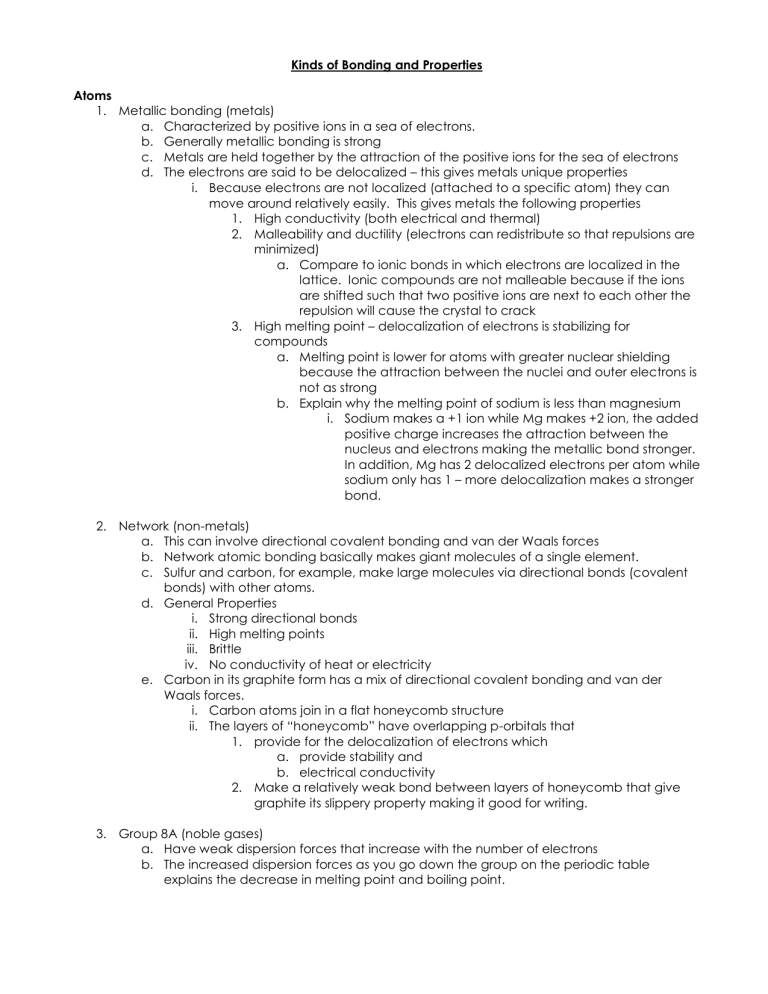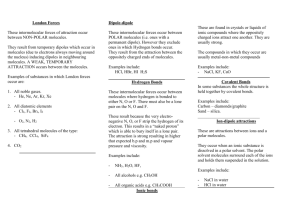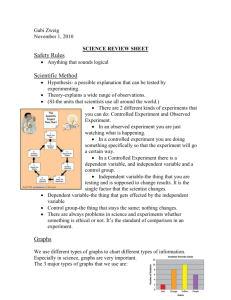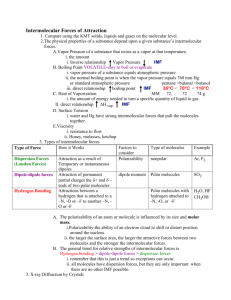KindsofBonding

Kinds of Bonding and Properties
Atoms
1.
Metallic bonding (metals) a.
Characterized by positive ions in a sea of electrons. b.
Generally metallic bonding is strong c.
Metals are held together by the attraction of the positive ions for the sea of electrons d.
The electrons are said to be delocalized – this gives metals unique properties i.
Because electrons are not localized (attached to a specific atom) they can move around relatively easily. This gives metals the following properties
1.
High conductivity (both electrical and thermal)
2.
Malleability and ductility (electrons can redistribute so that repulsions are minimized) a.
Compare to ionic bonds in which electrons are localized in the lattice. Ionic compounds are not malleable because if the ions are shifted such that two positive ions are next to each other the repulsion will cause the crystal to crack
3.
High melting point – delocalization of electrons is stabilizing for compounds a.
Melting point is lower for atoms with greater nuclear shielding b.
because the attraction between the nuclei and outer electrons is not as strong
Explain why the melting point of sodium is less than magnesium i.
Sodium makes a +1 ion while Mg makes +2 ion, the added positive charge increases the attraction between the nucleus and electrons making the metallic bond stronger.
In addition, Mg has 2 delocalized electrons per atom while sodium only has 1 – more delocalization makes a stronger bond.
2.
Network (non-metals) a.
This can involve directional covalent bonding and van der Waals forces b.
Network atomic bonding basically makes giant molecules of a single element. c.
Sulfur and carbon, for example, make large molecules via directional bonds (covalent bonds) with other atoms. d.
General Properties i.
Strong directional bonds ii.
High melting points iii.
Brittle iv.
No conductivity of heat or electricity e.
Carbon in its graphite form has a mix of directional covalent bonding and van der
Waals forces. i.
Carbon atoms join in a flat honeycomb structure ii.
The layers of “honeycomb” have overlapping p-orbitals that
1.
provide for the delocalization of electrons which
2.
a.
provide stability and b.
electrical conductivity
Make a relatively weak bond between layers of honeycomb that give graphite its slippery property making it good for writing.
3.
Group 8A (noble gases) a.
Have weak dispersion forces that increase with the number of electrons b.
The increased dispersion forces as you go down the group on the periodic table explains the decrease in melting point and boiling point.
Molecules - Intramolecular
1.
Ionic a.
Characterized by transfer of electrons between atoms and formation of crystal lattice b.
through electrostatic attraction of oppositely charged ions
Properties i.
Brittle - electrons are localized in the lattice. Ionic compounds are not malleable because if the ions are shifted such that two positive ions are next to each other the repulsion will cause the crystal to crack ii.
Non-conductive as a solid (since electrons can’t move…) iii.
Conductive when dissolved in water (ions separate and become charge carriers which transmit current). iv.
High melting point – strong attraction between ions gives these a high melting point v.
Soluble in water – polarity of water is able to attract ions away from each other so that they separate and become surrounded by water molecules.
2.
Covalent a.
Characterized by sharing electrons in a bond that is directional (between two specific atoms)
Molecules – Intermolecular
1.
Ionic – same as above
2.
Network Covalent – some molecules (ceramics, glasses, and some metal oxides) bond through network covalent bonding. Works the same as atomic network and gives same kinds of
3.
properties.
Dispersion forces a.
Weak forces from induced dipoles i.
Random movement of electrons can result in a bunch of electrons located on one side of the molecule which gives that side of the molecule a slightly negative charge. A molecule near it will have a positive charge induced on it as the electrons in it move away from the negative charge. b.
The large the molecule, the stronger the dispersion forces because of increased number of electrons.
Dipole-dipole forces a.
forces between permanent dipoles b.
Relatively strong when compared to dispersion forces and relatively weak when compared to intramoleuclar bonding. c.
Hydrogen bonds are a special case of dipole-dipole force involving hydrogen attached to a very electronegative atom such as O, N, F, and Cl. i.
Hydrogen bonds are stronger than dipole-dipole forces for molecules with the same mass ii.
Hydrogen bonding is often misunderstood because of its name. Hydrogen bonding is not a bond like a covalent bond or an ionic bond. It is an attraction between two separate molecules. iii.
We often say that molecules have hydrogen bonding which also promotes misconceptions. It is more accurate to say molecules experience hydrogen bonding.
4.
O This is NOT a hydrogen bond. This is a polar covalent bond.
H
H
H
O
H
O
These are hydrogen bonds. They are attractions between a partially positively charged atom on one molecule and a partially negatively charged atom on another molecule.
Coventional bonds make molecules.
Hydrogen bonds do not make molecules. They are attractions between molecules that are already made.
H H
How do intermolecular forces affect physical properties
1.
The stronger the intermolecular forces, the more the molecules will stick together.
2.
This will increase a.
melting point b.
i.
takes more energy to give the molecules enough energy to break some of the intermolecular forces so that they can move past each other boiling point i.
takes more energy to give molecules enough energy to completely separate from each other into the gas phase. c.
Viscosity i.
Viscosity it the resistance to flow ii.
The stronger the attractions between the molecules, the more they resist moving iii.
Honey and molasses are examples of high viscosity liquids d.
Surface tension i.
The stronger the intermolecular forces, the more effort it takes to break apart molecules on the surface
3.
Strong intermolecular forces will decrease a.
volatility (how easily a molecule evaporates). The weaker the forces, the more easily the molecules can escape to the gas phase b.
Vapor pressure (the pressure of gas above a liquid) i.
iii.
The more molecules in the gas phase, the higher the vapor pressure. ii.
Vapor pressure depends on temperature
1.
The ratio of vapor to liquid depends on temperature
There is always an equilibrium between states of matter
1.
For example at room temperature, water can exist as a liquid and a vapor (humidity). Water molecules are continuously evaporating and condensing in a dynamic equilibrium.
*****************************************************************************************************************This next bit is not really related to the topic but there are many misunderstandings about evaporation, boiling, and vapor pressure that I will address here anyway in hopes of making the real topic more clear
2.
You might ask – then why does a cup of water evaporate at room temperature? a.
A cup of water left open to the air will come to equilibrium with the system, which is the whole world – and the whole world has not yet reached equilibrium. It is still changing constantly.
3.
It is better to compare, for example a closed container of liquid nitrogen and liquid water
a.
Lets say you get a bottle wet so that you can see droplets of water on the inside) and then cap it. Will the bottle ever dry? i.
No. Not if the water can’t escape from the bottle b.
Let’s say you get another bottle of the same size and “wet” it with liquid nitrogen so that there is approx. just as many molecules of nitrogen as there was water in the other bottle. Will the nitrogen ever “dry”? i.
Yes, (assuming the change in pressure when the nitrogen evaporates is not significant enough to keep the nitrogen in its liquid phase which is why this example requires only a iv.
small amount of liquid) because nitrogen’s boiling point is much lower than room temperature so nitrogen cannot exist as a liquid at room temperature unless under very high pressure.
The difference between evaporation and boiling point
1.
evaporation a.
occurs when molecules or atoms have enough kinetic energy to b.
the melting point and boiling point)
2.
Boiling point a.
break the intermolecular forces holding them in the liquid phase and escape to the gas phase. occurs at many temperatures (every temperature point between occurs when the vapor pressure = the ambient pressure b.
occurs at one temperature, for a given atmospheric pressure,
This site has a great explanation of the difference: http://wine1.sb.fsu.edu/chm1045/notes/Forces/Vapor/Forces05.htm
*****************************************************************************************************************
4.
Solubility a.
Generally solubility follows the rule “like dissolves like” i.
Polar + Polar = miscible ii.
Non-polar + Non-polar = miscible iii.
Polar + non-polar = immiscible iv.
Polar + ionic = miscible v.
Non-polar + ionic = immiscible b.
This rule stems from the strength of intermolecular forces i.
Ionic compounds are sufficiently attractive to break the attraction between
polar solvent molecules and hence will dissolve ii.
Polar compounds are also sufficiently attractive to break the attraction between
polar solvent molecules and hence will dissolve iii.
Non-polar molecules are not sufficiently attractive to break the attraction between polar solvent molecules and hence will not dissolve
1.
polar and non-polar molecules do NOT repel
2.
non-polar molecules are attracted to polar molecules more than they are attracted to other non-polar molecules. (This is why an oil drop is a iv.
sphere until it lands on the surface of water and spreads out.) BUT not as much as polar molecules are attracted to other polar molecules.
However, non-polar molecules are sufficiently attractive to break the attraction between non-polar solvent molecules and hence will dissolve c.
Some molecules have both polar and non-polar parts i.
Emulsifiers or surfactants like soap are capable of mixing in both polar and nonpolar solvents ii.
Organic molecules with OH groups will dissolve in polar solvents if their non-polar parts are sufficiently small.
1.
ethanol (2-carbon chain) is soluble in water
2.
Larger carbon-hydrogen chains (anything larger than about 4 carbons) begin to be insoluble (even if they have an –OH group)
d.
There are two forces at work when a solute dissolves in a solvent i.
The energy change (how much energy is required to break the intermolecular forces and how much is released when the new intermolecular “bonds” are made). If there is more energy given off in the formation of new intermolecular
“bonds” this can be a reason a substance will dissolve.
1.
The energy given off when ionic compounds dissolved in water is a major driving force for the dissolution of ionic solids in water. Sometimes the energy is significant enough to detect a change in temperature. ii.
The increase in entropy which always occurs when a substance dissolves is another driving force of the process iii.
Large non-polar molecules cannot make as many strong intermolecular “bonds” as polar molecules. The energy change for a non-polar solute dissolving in a polar solute is so unfavorable that it outweighs the increase in entropy.
5.
Colligative properties a.
When a solvent has something dissolved in it, i.
the boiling point of the solvent is elevated ii.
the freezing point is lowered b.
This happens because the vapor pressure is lowered, fewer molecules of solvent are escaping to the gas phase when a solute is present i.
Fewer molecules have the ability to escape to the vapor phase because of the strong attraction between the solute and the solvent molecules. ii.
Remember the definition of boiling point: point at which vapor pressure equals iii.
the pressure of atmosphere.
Using the phase diagram below, you can see the effect of adding a solute on the freezing point and boiling point
1.
Boiling point increases
2.
Freezing point decreases
Pressure
(atm)
1.00
0.0060
-1.5
0.00
100.0
105.0
Temperature ( C)
6.







